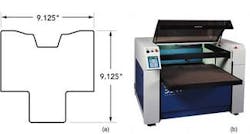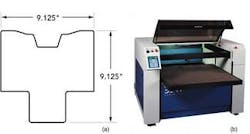Machining acrylic displays
Displays2Go Inc.—a major national point-of-purchase (POP) display fabricator with an emphasis on fabricating acrylic displays—wanted to increase manufacturing capacity while reducing overall costs and increasing manufacturing flexibility. Having traditionally used routers to cut acrylic components of POP displays, the Bristol, Rhode Island-based Displays2Go purchased its first laser cutting and engraving machine—a 100W laser with a 32 × 18 in. cutting bed—last year.
Initially, the company's primary goal was to engrave signage while cutting small lots of odd-shaped pieces. Production personnel recognized the benefits of laser cutting versus routing, such as dust-free cutting (especially important when pieces were to be silk-screened) and fewer production steps because laser-cut pieces have an optically clear edge—eliminating the need for flame polishing. Also, router bits no longer had to be sharpened and the contactless cutting aspect of lasers enables the material to be unmasked and silk-screened in bulk prior to cutting rather than peeling and printing small individual pieces.
The company realized that these advantages in mass production would require a larger and more powerful system. Even with these obvious advantages, the throughput of the system would have to compensate for the inability to stack and process multiple sheets of material in one cycle. With handheld routers and good templates the company would often cut from six to eight pieces of 0.080-in. thick acrylic in one pass.
The Displays2Go team still felt that substantial time and money could be saved and began to study whether an economic benefit existed in laser processing mass-produced pieces.
Application description
The company decided against evaluating laser systems based on performance data quoted in vendor brochures. Instead, it devised a plan to benchmark systems using actual application data that would be gathered by providing a standard part and material to each vendor, and by visiting each vendor to understand how the system would perform once installed.
The company decided to use the part it cuts most frequently as the benchmark—a brochure holder made from 0.080-in. extruded acrylic. Shown in Figure 1 is an irregular shape that is cut flat and then bent using heated line benders.
To establish a baseline, the production team set out to process 10,000 parts using its existing laser system. With a limited cutting area, the existing system was able to cut six of these parts at once (six-piece file). The following are results and observations from trying to run production quantities on the smaller platform: The fastest cycle time achieved: 2:15 minutes for six-piece file.
Both sides of the film masking the acrylic had to be left in place. The laser produced hazing or cloudiness on the surface of the acrylic with the film masking peeled off. Loading and unloading the machine was slightly cumbersome and inefficient, because the operator had to lift the lid and reach into the machine to access the cutting area. There was considerable downtime for the operator—even with peeling the film from finished parts, the operator had more than 1.5 minutes of extra time to stand and watch the laser cut. The laser operator was able to produce from 1100 to 1300 pieces per day. Shop operators were simultaneously achieving 1800 pieces per day by hand routing and flame polishing the parts. It was simply more efficient to do it the old-fashioned way.
Realizing that a second laser machine running in tandem could double their output, the company decided to move forward. However, the additional cost of a second machine would have to be economically justified. This would require workflow designed to maximize the operator's efficiency and machine utilization. Hazing would have to be addressed either by employing a more powerful laser, faster cut rate, assist gas or a combination of the three. A much larger cutting area would be necessary to achieve the required production capacity.
Their existing laser system was the largest and most powerful model offered by the manufacturer, thus the search began for a more optimal laser cutting system. In order to make an informed buying decision, the company created the following list of criteria to evaluate laser systems.
Indexed speed or throughput
Displays2Go realized that a laser system's cut rate is affected by several variables: laser power produced at the nozzle; type and thickness of the substrate being cut; finished edge quality tolerances; number of directional changes in the part being processed; actual acceleration speed of the gantry mechanism; and the type of motors used (stepper, servo, linear) and their associated slew speed.
The only sure way to objectively measure throughput would be to ask each vendor to cut a common part—in this case the six-piece file described above was cut on extruded acrylic with one side of the film masking peeled off. The company would then use cut time and resulting edge quality to gauge the results.
Exhaust system
Cutting acrylic creates noxious fumes and there is a residual odor to the acrylic edges. The company knew it could not do anything about residual odor, but needed to mitigate the process odors. To do this, fumes would need to be extracted from both the top and the bottom of the cutting surface. Further, the machine needed to be fully enclosed to prevent fumes from drifting throughout the manufacturing area. A machine with a Class 1 type enclosure and an efficient exhaust system was necessary.
Haze-free cutting
Lasers cut acrylic by ablating molecules inside the kerf. This process produces heat on the material surface near the cutting line—referred to as the heat affected zone (HAZ). Gas released during the cutting cycle has a tendency to brush the HAZ leaving a permanent cloudy residue. The challenge for laser machine manufacturers is to remove gas from the kerf during cutting so that it cannot accumulate on the HAZ and leave a finished edge quality. By addressing this issue the company could cut the acrylic with one side unmasked—a key driver of the project's economics.
Workflow capabilities
With as much as a 300 percent difference in output between various workflow methodologies, this turned out to be the defining parameter that separated most of the vendors—and the most critical to measuring the value of the project. In the company's high production environment, it would be essential to ensure the machine utilization rate was maximized.
The solution
After researching and evaluating several options, the company chose the LMC5010 from Beam Dynamics (San Carlos, CA) based on the qualities and performance of the machine as well as that supplier's reputation for quality. The final solution consisted of the following: two LMC5010s with 250W sealed CO2 laser tubes from Coherent (Santa Clara, CA) and two 4 × 8 ft dual-pallet tables with shuttle capabilities.
The LMC exceeded all of the company's functional and technical criteria while maximizing the project return-on-investment.
Throughput
Beam Dynamics demonstrated and was able to contractually commit to 3:00 minute cut time for a 30-piece file (roughly 36 seconds for the original six-piece file versus 2:15 minutes on the existing machine). This was accomplished through high-acceleration, look-ahead contouring and exceptional beam quality. With a Class 1 enclosure, vacuum table and overhead exhaust, the LMC exhibits the best fume extraction of all machines tested.
As stated previously, unmasking the acrylic sheets prior to cutting was essential to the project's success. To achieve haze-free results, gas must be forced down through the cut line and evacuated quickly. Beam Dynamics' proprietary nozzle and fume evacuation system guaranteed haze-free cutting at full feed rates.
Workflow capabilities
The LMC proved the most flexibility in terms of workflow and operating scenarios. It is the only machine evaluated that provided the company's ideal solution—single-side loading with stacked 4 × 8 ft material pallets.
Single-side loading eliminates the need for redundant floor space for finished goods, raw materials and scrap. It also saves the operator significant "walk-time" by not running around the machines throughout the process. Stacked pallets allowed the operator to shuttle pallets in and out of the machine thereby keeping the operator and both machines running at 100 percent.
Results
As a culmination of all the variables mentioned above, Displays2Go now expects to produce more than 6300 parts per day with just one operator versus its current run rate of 1800 parts per day.
By eliminating downstream production processes, significantly reducing labor costs and doing away with router-related maintenance charges, Displays2Go has realized substantial cost savings and expects the laser systems to pay for themselves in less than one year.
Further, the increased production capacity and manufacturing flexibility afforded by the laser systems will allow Displays2Go to be even more competitive.
Mike Hadley is director of marketing and business development for Beam Dynamics Inc., San Carlos, CA. Contact him by e-mail at [email protected].

